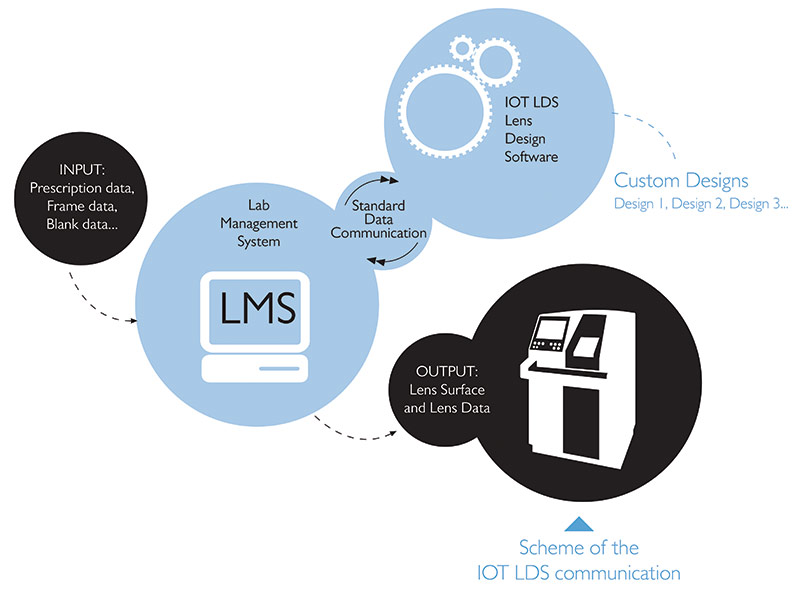Sponsored by IOT
By Deborah Kotob, ABOM
I recently did a bit of “light” reading in Modern Ophthalmic Optics, co-authored by two of IOT’s founders, Jose Alonso and Juan A. Quiroga. Professors Alonso and Quiroga are more than names on a book cover for me. I met them when I visited the IOT research facility in Madrid, Spain, and I was humbled by the experience. Talking with them made me feel grateful such brilliant minds exist to advance such beneficial science and technology.
Reading from their book made me appreciate the enormity of the free-form technology revolution. Take a look at a few excerpts from Modern (“Free-Form”) Lens Design, published in Modern Ophthalmic Optics, Chapter 6.4, pages 231 and 232, covering a brief history and evolution of conventional to free-form lens design and surfacing technology.

The authors explain that while merit functions allowing for general lens optimization existed before the end of the 20th century, their full potential could not be applied to lens design until the introduction of free-form technology.
They go on to explain the limitation of designing aspherical blanks using merit functions before the introduction of free-form surfacing technology: “…the final performance of these blanks would be limited by the fact that each blank had to be shared by a large number of different prescriptions as well as different frames and user characteristics.”
“Prior to the free-form technological revolution, lens generators and polishers used in RX-labs could only shape spherical and toric surfaces. Lens manufacturers could use aspherical semifinished blanks, but their flexibility was highly reduced by the small number of different base curves and fixed values of asphericity,” the authors state.
Schneider launched the first equipment for fast free-form optical lens surfacing in 1998. Free-form surfacing basically consists of using computer numerically controlled (CNC) techniques to guide the cutting tools and polishing pads to shape virtually any surface. Free-form technology was available to the optics industry years earlier, but it was a lengthy process. The Schneider free-form equipment breakthrough allowed free-form labs to cut and polish arbitrary surfaces in less than two minutes. Free-form labs are not limited to spherical and toric surfaces; they can shape spherical, conicoid or complex surfaces defined by Zernike polynomials or an even larger number of spline coefficients. Free-form lens designs can now optimize and customize the lens surface using a large set of parameters.
The authors credit free-form manufacturing as the enabler of the most important breakthrough in the ophthalmic industry—the creation of customized lenses. They state: “Customization starts with the reduction of oblique errors. Free-form technology allows the generation of the specific surface for which oblique errors are reduced the most. Conversely, the standard manufacturing process can only hope to provide a lens with a bending factor that will avoid very strong oblique errors, and that bending factor, or base curve, is shared with many other prescriptions with different values of sphere and cylinder.” Furthermore, other factors can be accounted for when computing free-form surfaces for customized lenses. For example, we are familiar with the pantoscopic tilt angle, which introduces oblique astigmatism at the center of the lens and increases oblique aberrations in the upper half. We are also familiar with the wrapping angle, where the temple side of the frame is angled to sit closer to the face. With this lens tilt angle, vision is typically worse nasally. Other familiar factors that can be accounted for in the computation of a free-form surface include the refractive index of the lens material, the frame shape parameters and the naso-pupillary distances.
There are also two less familiar factors that can be incorporated into free-form surface calculations. First, when a prescribed prism is present, it produces different oblique aberrations that can be compensated by a proper redesign of the free-form surface. Second, the distance to COR has an effect on optimal lens design. Before free-form technology, an average distance to COR value of 27 mm was used, but this value can vary from 24 mm to 30 mm. If we measure the distance to COR and feed this value to the surface calculation system, off-axis lens performance will be improved.
Patients now benefit from a level of optimization and precision optics customized to them, all thanks to the combination of proper lens-design software and free-form surfacing equipment.












